A multi-pronged approach to mitigate corrosion is one of the hallmarks of a giant arched shelter that was recently slid into place over the Chernobyl nuclear disaster site in Ukraine.
Called New Safe Containment (NSC), the structure is 108-m high and 162-m long, with a span of 257 m.1 Designed to last at least 100 years, the device will cover the remains of the No. 4 unit at the Chernobyl nuclear power plant, which exploded on April 26, 1986 after a botched test.
The NSC is designed to withstand temperatures ranging between -43 °C and +45 °C, as well as most tornadoes and earthquakes. The facility is equipped with two automated, camera-equipped cranes with a lifting capacity of 50 tons each, as well as other associated equipment to enable the dismantling of the unit responsible for the original disaster.
The structure was slid over Chernobyl in late November 2016, and the project is scheduled for full completion later this year.2
“We welcome this milestone in the process of the transformation of Chernobyl as a symbol of what we can achieve jointly with strong, determined, and long-term commitment,” Suma Chakrabarti, president of the European Bank for Reconstruction and Development (EBRD) (London, United Kingdom), observed in a special ceremony.

Need for the Structure
The reactor explosion caused 31 direct deaths and led to nuclear fallout across Europe, with the radiation causing extensive pollution, radiation exposure, and long-lasting ecological damage. The reactor was initially encased in a concrete sarcophagus to prevent the further spread of radioactive dust, but the hastily-built sarcophagus had no welded or bolted joints. Moreover, openings in the roof allowed water in, resulting in corrosion—thus putting the entire structure at risk of collapse.
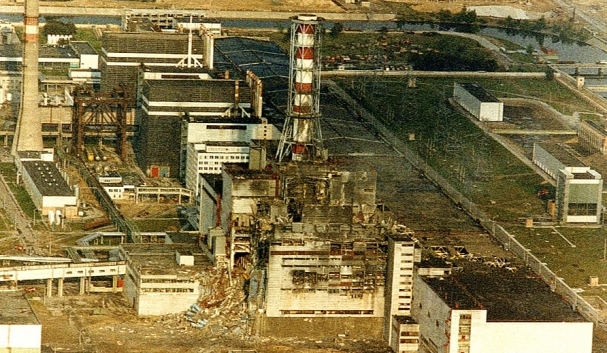
As a result, a solution was needed that not only would contain the existing radioactive site, but also protect against the corrosion problem that made the initial encasement unworkable. In addition, with the ongoing radiation leak making maintenance visits difficult, project officials knew they needed a solution that would fight corrosion over the long haul.
Coating Specifics
Rustproof stainless steel (SS) was chosen by developers for both the exterior and interior of the structure, since there would be no safe way for workers to scrape and repaint it.
The exterior shell of the structure is comprised of 945,000 ft2 (87,793 m2) of Type 316L SS with 2% molybdenum, which provides enhanced corrosion resistance.
The primary containment surface includes 855,000 ft2 (79,432 m2) of Type 304 SS. For the containment surface, 20-mil-thick (508-μm) plates were tightly fitted to a galvanized deck with no ribbing, thereby reducing the probability of any radioactive dust sticking to the surface. The annealed SS panels were sealed with tape and radioactive-resistant silicone to maintain an airtight space.
Whereas the original sarcophagus had no welded or bolted joints, the NSC includes 750,000 tension control bolts to hold the structure together. For enhanced corrosion resistance, Greenkote (Brook Park, Ohio) licensed its patented zinc-based dry thermal diffusion coating process to Tension Control Bolts Ltd. (Wrexham, United Kingdom), the manufacturer of the high-strength friction grip and preloaded bolting system chosen for the NSC.3
The coating system removes the risk of hydrogen embrittlement in bolts, is harder wearing than galvanizing, and readily accepts all paint systems.
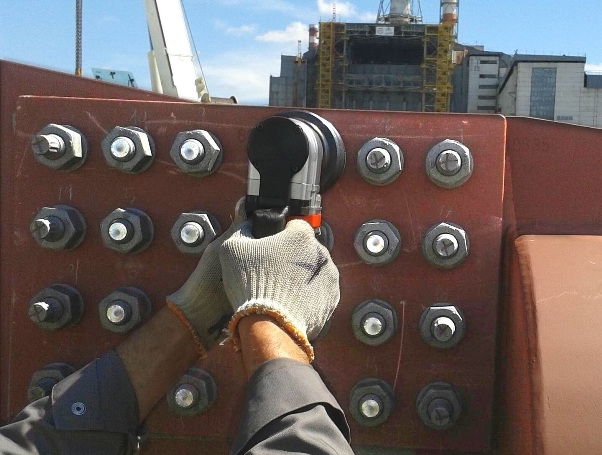
“Our ability to offer the combination of a fast and effective pre-loaded assembly system with bolts protected by Greenkote was a significant factor in the decision to use our product,” says Tim Stokes, managing director of Tension Control Bolts. “Moreover, we are able to give a 150-year, lifetime guarantee.”
“The coating’s thermal diffusion process offers exceptional corrosion protection and longer wear,” says Greenkote CEO Mark Gore. “The Chernobyl project is a high point for us, as there can be few other applications where a high-performance coating and protection system is so important when it comes to guaranteeing the structural integrity of a design.”
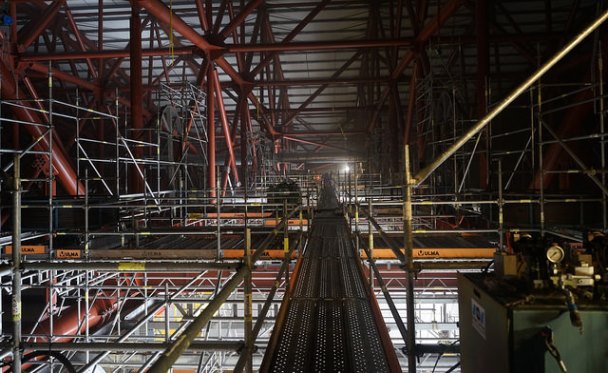
Ventilation System
But even with those precautions, developers wanted an extra layer of security to ensure that no corrosion could develop. To that end, perhaps the most noteworthy angle of the NSC’s anticorrosion properties is the innovative ventilation system for the arch’s 12-m annulus4 between the inner and outer layers of the structure, where the steel supports and beams come together.
The entire arch annulus will be maintained at a slight, positive pressure of about 50 Pa—and the containment area inside at a slight negative pressure—to ensure that no radioactive particles migrate up and into the annular space.
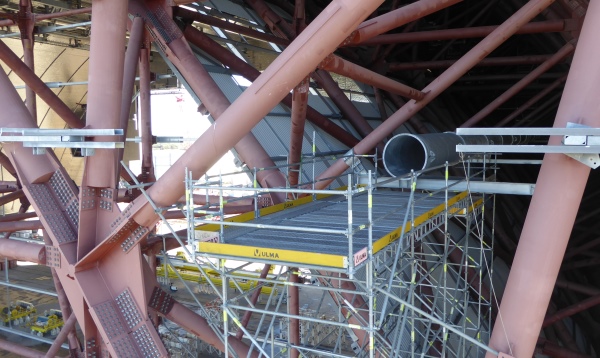
Furthermore, dehumidifiers will treat the lightly pressurized air in the annular space to maintain the relative humidity at below 40%. At that level, developers say the electrolytes necessary to produce corrosion will not form.
The ventilation system is comprised of an inlet drying system, nine recirculation systems, and over 100 air-handling units in all, according to the EBRD. The system will recirculate around 45,000 m3 of air each hour, thereby enabling the NSC to avoid water ingress from outside and dust from inside.
What Comes Next
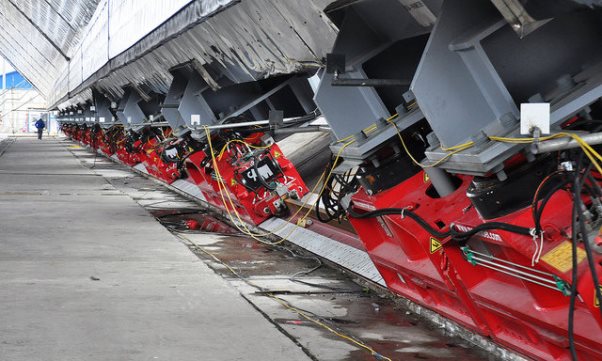
The sliding of the NSC was completed using a special skidding system consisting of 224 hydraulic jacks, which pushed the arch 600 mm with each stroke. It took five days, or 40 working hours, for workers to move the structure to the reactor site from the nearby, radiation-free field where it was constructed.
On November 29, 2016, project officials declared the arch to be fully in place. A time-lapse video of the full arch sliding can be viewed here.
With the sarcophagus now covered, the final step of the multi-year undertaking at Chernobyl is the second stage of erecting the facility’s end walls. That is currently scheduled for completion in August 2017, and represents the long-awaited conclusion of the landmark project.
“We were not building this arch for ourselves," says Igor Gramotkin, director general of the Chernobyl Nuclear Power Plant. “We were building it for our children, for our grandchildren, and for our great-grandchildren. This is our contribution to the future, in line with our responsibility for those who will come after us.”
The 36,000-ton arch project, estimated to cost over $2 billion and operated by the EBRD, was first designed in 1997 and has been under construction since 2010. Funds have been contributed by Ukraine, Russia, numerous Western nations, and the EBRD itself.5
Source: EBRD, ebrd.com, Contact: Dermot Doorly, e-mail: doorlyd@ebrd.com.
References
1 “Chernobyl: a site transformed,” European Bank for Reconstruction and Development: Nuclear safety, http://www.ebrd.com/what-we-do/sectors/nuclear-safety/chernobyl-overview.html (Jan. 12, 2017).
2 “Unique engineering feat concluded as Chernobyl arch has reached resting place,” EBRD Press Office, Nov. 29, 2016,
http://www.ebrd.com/news/2016/unique-engineering-feat-concluded-as-chernobyl-arch-has-reached-resting-place.html (Jan. 12, 2017).
3 “Greenkote TCB Bolts at the Core, As Chernobyl New Safe Confinement Shelter Nears Completion,” PRLog, Oct. 29, 2015, https://www.prlog.org/12506446-greenkote-bolts-at-the-core-as-chernobyl-new-safe-confinement-shelter-nears-completion.html (Jan. 12, 2017).
4 V. Novak, “The Chernobyl New Safe Confinement History and Outlook,” European Bank for Reconstruction and Development, March 2016, http://www.ebrd.com/documents/nuclear-safety/pdf-chernobyl-new-safe-confinement-press-kit.pdf (Jan. 12, 2017).
5 I. Nechepurenko, H. Fountain, “Giant Arch, a Feat of Engineering, Now Covers Chernobyl Site in Ukraine,” New York Times, Nov. 29, 2016, https://www.nytimes.com/2016/11/29/world/europe/chernobyl-disaster-cover.html (Jan. 12, 2017).